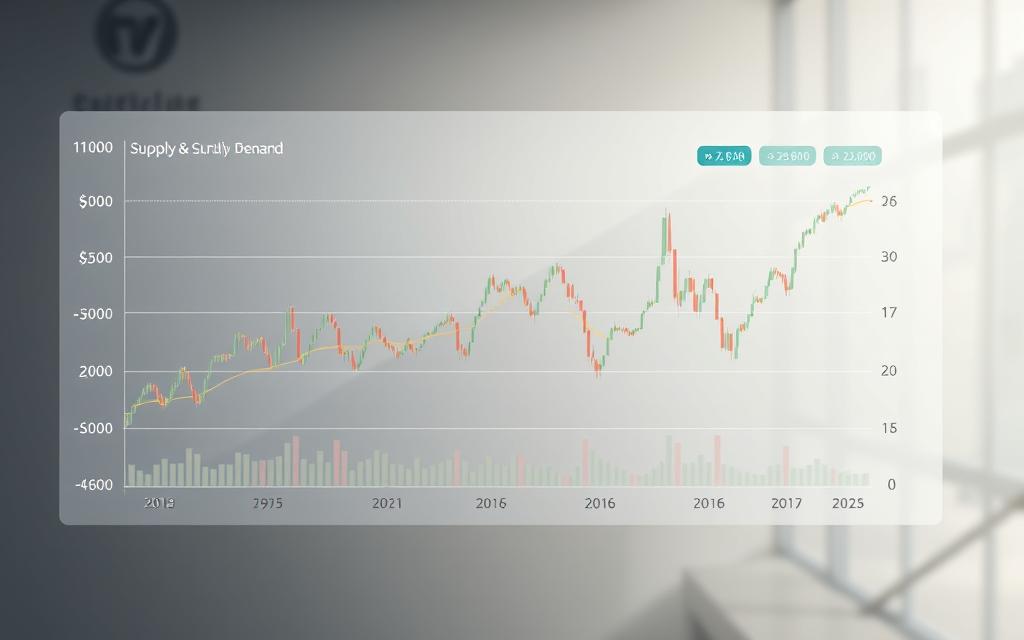Table of Contents
Cryptocurrency markets are known for their extreme volatility. Daily price swings of 5-15% are common, unlike traditional fiat currencies backed by governments. This wild fluctuation stems from digital assets’ decentralized nature and limited real-world adoption.
Three core factors drive valuation changes in this emerging asset class. Supply and demand mechanics create scarcity for coins with limited issuance. Market perception shifts rapidly based on news and investor sentiment. Fierce competition among thousands of projects also impacts individual token performance.
This article explores the complex ecosystem influencing digital currency valuations. We’ll analyze ten key elements that determine price movements, from mining costs to regulatory developments. Understanding these dynamics helps investors navigate the unpredictable cryptocurrency landscape.
Introduction to Cryptocurrency Volatility
Unlike stable stocks, cryptocurrencies can swing dramatically within hours. Bitcoin’s 2021 rally to $65,000 and subsequent 50% drop exemplifies this volatility. Such price swings are routine in the crypto market, where 10% daily moves are common.
Traditional assets pale in comparison. Stocks average 1% daily changes, while bonds rarely shift beyond fractions of a percent. The table below contrasts typical fluctuations:
| Asset Class | Average Daily Move | Notable Extreme |
|---|---|---|
| Bitcoin | 5-10% | +20%/-30% (2022) |
| S&P 500 | 0.8-1.2% | +4%/-5% (2020 crash) |
| Gold | 0.5-1% | +3%/-6% (2023) |
Decentralization fuels this instability. Without central banks to stabilize values, cryptocurrencies trade purely on investor sentiment. The 2022 Terra/Luna collapse (-99%) and Ethereum’s merge anticipation show how perception drives prices.
Thin liquidity worsens swings for smaller coins. With fewer buyers and sellers, trades trigger larger price swings. As analysts note, even Bitcoin’s $600B+ market cap isn’t immune to sudden drops.
What Makes Crypto Go Up? Core Drivers Explained
Digital asset valuations hinge on fundamental economic principles. Like traditional commodities, supply and demand dynamics create price floors and ceilings. However, blockchain tokens add unique twists to these mechanics.

Supply and Demand Dynamics
Bitcoin’s 21 million cap exemplifies artificial scarcity. With 3 million BTC permanently lost and halvings reducing new supply, demand surges often trigger rallies. Ethereum’s EIP-1559 upgrade introduced burns, removing ETH from circulation during network congestion.
Stablecoins like USDT further influence price movements. Large minting events correlate with exchange reserve buildups, often preceding bullish trends. Coinbase’s BASE chain increased ETH demand by funneling fees back into the Ethereum ecosystem.
Fixed vs. Infinite Supply Tokens
Bitcoin’s predictable issuance contrasts sharply with inflationary tokens. Dogecoin’s 5 billion annual minting dilutes holdings unless adoption outpaces new coins. Projects with burning mechanisms, like Ethereum post-merge, mimic scarcity benefits of capped supplies.
- Bitcoin: 2140 supply endpoint with quadrennial halvings
- Ethereum: Deflationary since EIP-1559 (1.2% annual burn rate)
- Dogecoin: 5% annual inflation with no hard cap
These structural differences explain why some cryptocurrencies maintain value better during downturns. Investors increasingly prioritize tokenomics when allocating capital.
The Role of Mining and Production Costs
Production costs create a price floor for cryptocurrencies like Bitcoin. Miners invest heavily in hardware and energy to secure the network, influencing token valuation. When mining costs rise, selling below break-even becomes unsustainable.
Bitcoin’s mining difficulty adjusts every 2016 blocks to maintain a 10-minute block time. During the 2022 crash, miners faced costs near $45k per BTC—forcing inefficient operators offline. This self-correcting mechanism stabilizes supply during market downturns.
Ethereum’s transition to proof-of-stake introduced a “difficulty bomb” to discourage mining. This deliberate slowdown pushed miners toward the new consensus model, reducing energy use by 99%.
| Mining Factor | Bitcoin | Ethereum (Pre-Merge) |
|---|---|---|
| Hardware | ASIC-dominated | GPU-friendly |
| Energy Use | ~127 TWh/year | ~44 TWh/year |
| Break-even Price (2022) | $45,000 | $1,500 |
Geopolitics reshaped mining hubs after China’s 2021 ban. Texas emerged as a leader, leveraging deregulated energy markets. Renewable-powered farms now compete with fossil-fuel operations, cutting long-term costs.
The ASIC arms race drives efficiency but centralizes mining power. Companies like Bitmain dominate hardware production, creating supply bottlenecks. Smaller miners increasingly rely on renewable energy to offset rising electricity expenses.
Market Perception and Investor Sentiment
Investor psychology often dictates cryptocurrency price movements more than fundamentals. The crypto market behaves like a voting machine in the short term, where sentiment outweighs technical analysis.
Media Influence and Public Trust
News cycles create self-fulfilling prophecies in digital assets. When CoinDesk reports bullish trends, retail investors typically follow within 48 hours.

Elon Musk’s 2021 Twitter posts moved markets dramatically. His Bitcoin endorsement caused a 20% price surge, while subsequent Tesla payment reversals triggered selloffs.
“Social volume precedes price action by 12-72 hours across major assets.”
Three media patterns drive demand spikes:
- Exchange listing rumors (Binance effect)
- Regulatory clarity breakthroughs
- Celebrity endorsements with proof of holdings
Case Study: Bitcoin’s 2021 ETF Surge
The ProShares BITO ETF approval demonstrated institutional power. Bitcoin rallied 35% in two weeks as investors anticipated new demand channels.
| Event | Price Impact | Duration |
|---|---|---|
| ETF Filing Announcement | +18% | 5 days |
| SEC Approval | +12% | 2 days |
| First Trading Day | +5% | 24 hours |
Michael Saylor’s $6B acquisition strategy revealed another pattern. Institutional accumulation often occurs during negative news cycles when retail investors panic sell.
True adoption grows when these psychological patterns become predictable. The market now anticipates “buy the rumor” movements before major announcements.
Competition Among Cryptocurrencies
With over 23,000 tokens in existence, the crypto space has become fiercely competitive. Projects battle for developer attention, investor capital, and real-world utility. This Darwinian environment separates enduring protocols from short-lived experiments.

Layer 1 networks lead the most intense competition. Ethereum maintains dominance with 57% of TVL, but Solana’s 400% growth in 2021 showed challenger potential. Avalanche and Cardano continue evolving their ecosystems to capture value.
Key protocol differentiators include:
- Transaction speeds (Solana: 2,700 TPS vs Ethereum: 15 TPS)
- Gas fees (Avalanche: $0.10 average vs Ethereum: $5+ during peaks)
- Developer activity (Ethereum leads with 4,000+ monthly commits)
Meme coins create another market segment where community strength outweighs technology. Dogecoin’s first-mover advantage faces pressure from Shiba Inu’s ecosystem and newer entrants like Bonk. These tokens demonstrate how cultural relevance drives valuations.
“The top 5 stablecoins control 98% of the $130B market, creating intense rivalry for payment integrations.”
Binance Launchpad reshapes the competitive landscape monthly. New tokens gaining exchange listings often see 50-100% price surges. This launch platform has propelled projects like Axie Infinity and Polygon into the market spotlight.
Ultimately, the most successful cryptocurrencies deliver lasting value beyond hype cycles. As competition intensifies, projects must innovate or risk obsolescence in this fast-moving industry.
Adoption by Businesses and Institutions
Corporate adoption has become a major catalyst for cryptocurrency valuations. When Fortune 500 companies allocate treasury funds to digital assets, it signals long-term confidence to investors. This institutional validation often precedes retail adoption waves.

Corporate Treasury Strategies
MicroStrategy pioneered the Bitcoin treasury reserve model in 2020. Their $8 billion accumulation demonstrates how companies leverage crypto for:
- Inflation hedging (outperforming cash reserves by 300%)
- Balance sheet gains (unrealized profits during bull markets)
- Tax-efficient capital allocation (debt financing strategies)
Tesla’s $1.5 billion BTC purchase in 2021 created a blueprint for tech firms. Though they later sold 75%, the move legitimized crypto as corporate treasury money. Fidelity now offers Bitcoin 401(k) options, further bridging institutions and digital assets.
Payment Infrastructure Evolution
Visa’s crypto card partnerships processed $2.5 billion in 2022. Their collaborations with Coinbase and BlockFi show how traditional finance integrates blockchain services.
| Processor | Innovation | User Impact |
|---|---|---|
| PayPal | PYUSD stablecoin | 70M merchants gain crypto access |
| Shopify | Native crypto payments | 1.7M businesses accept digital currencies |
| Stripe | Fiat-to-crypto onramps | Reduced conversion friction |
Starbucks Odyssey blends NFTs with loyalty programs. Members earn adoption points convertible for rewards, creating real-world utility. SWIFT’s blockchain experiments aim to settle cross-border transactions faster, potentially saving banks $10B annually.
“Enterprise adoption follows a predictable pattern: treasury reserves → payment rails → consumer-facing services.”
From Overstock’s 2014 Bitcoin acceptance to today’s institutional infrastructure, businesses now view crypto as both investment and operational tool. This trend drives sustainable gains beyond speculative trading.
Regulatory Changes and Government Policies
Legal frameworks shape cryptocurrency markets as much as technology or economics. The government stance on digital assets creates waves across exchanges, influencing investor confidence and market stability. Recent years have shown how policy shifts can trigger immediate price reactions.
SEC vs. CFTC Jurisdiction Battles
The U.S. faces a regulatory tug-of-war between agencies. The SEC classifies most tokens as securities, while the CFTC views them as commodities. This conflict creates confusion for firms navigating compliance risks.
Key developments include:
- SEC’s 2023 lawsuits against Coinbase and Binance over unregistered securities
- CFTC’s successful case against FTX for derivatives violations
- Ongoing debates about stablecoin oversight between banking regulators
Europe’s MiCA framework offers contrast. Their unified approach provides clearer rules for crypto firms. Analysts note this gives EU markets stability advantages over the fragmented U.S. system.
Impact of Taxation Rules
IRS policies significantly affect cryptocurrency market behavior. Form 8949 requirements force investors to track every transaction. Unlike stocks, crypto lacks wash sale rules – allowing strategic tax-loss harvesting.
| Tax Consideration | Crypto | Stocks |
|---|---|---|
| Wash Sales | Not applicable | 30-day rule |
| Reporting Threshold | $600+ (Form 1099) | $10+ (Form 1099) |
| Gift Tax Rules | Same as property | Different treatment |
Hong Kong’s pro-crypto licensing shift shows alternative approaches. Their 2023 framework attracts businesses while maintaining oversight. The FATF Travel Rule creates global compliance challenges, requiring exchanges to share sender/receiver data for transfers over $3,000.
“Regulatory clarity remains the missing piece for mainstream institutional adoption.”
The FTX collapse accelerated policy changes worldwide. Lawmakers now prioritize consumer protection while balancing innovation. These evolving regulation landscapes create both risks and opportunities for informed investors.
Global Economic Conditions
Global financial trends increasingly influence digital asset valuations as traditional and crypto markets intertwine. The 2020-2021 period proved this connection when Bitcoin surged 600% alongside unprecedented money printing by central banks.
Fidelity’s research shows a 0.77 correlation between BTC and the S&P 500 during market stress. This relationship fluctuates based on economic conditions:
Hyperinflation economies demonstrate crypto’s hedge potential. Argentina saw 300% growth in digital wallet registrations during its 2022 currency crisis. Venezuela’s Petro experiment failed due to forced adoption, but organic BTC usage grew 400%.
“When fiat currencies weaken, investors consistently allocate to scarce digital assets as preservation tools.”
The US Dollar Index (DXY) shows an inverse pattern with major cryptocurrencies. When the dollar weakens, crypto demand typically rises as shown below:
| DXY Movement | BTC 30-Day Reaction | ETH 30-Day Reaction |
|---|---|---|
| -5% | +22% average | +18% average |
| +5% | -15% average | -12% average |
Interest rate hikes create short-term pressure but long-term opportunities. The 2022 Fed increases initially crashed markets, yet savvy investors accumulated during dips. Gold’s 5% annualized returns since 2020 trail Bitcoin’s 58%, challenging traditional safe-haven assumptions.
These economic forces prove digital assets now respond to macro trends like mature markets. Understanding these connections helps navigate inflation cycles and currency fluctuations.
Technological Upgrades and Network Events
Blockchain networks evolve through scheduled upgrades that reshape market dynamics. These technical milestones often trigger significant price movements as investors anticipate improved functionality or supply changes. The crypto space has witnessed several landmark events that redefined entire ecosystems.
Bitcoin Halving Cycles
Bitcoin’s quadrennial halving events slash mining rewards by 50%, creating predictable supply shocks. Historical data shows remarkable patterns around these events:
- 2012: 8,000% ROI in following year
- 2016: 300% gain within 18 months
- 2020: Preceded 300% rally (Motley Fool data)
The 2024 halving will reduce daily issuance from 900 to 450 BTC. This artificial scarcity has historically boosted Bitcoin’s valuation as demand outpaces new coin creation.
Ethereum’s Proof-of-Stake Transition
Ethereum’s 2022 merge marked a pivotal shift from energy-intensive mining to staking. The upgrade delivered:
| Metric | Change |
|---|---|
| Energy Use | 99.95% reduction |
| Issuance Rate | 90% decrease |
| Validator APR | 4-7% post-merge |
“MEV-boost relays now capture 90% of transaction ordering, creating new validator economics.”
The upgrade enabled innovative features like sharding while making ETH a deflationary asset during high network usage.
Layer 2 and Smart Contract Evolution
Recent technical advances extend beyond base layer improvements:
- Taproot: Enabled complex Bitcoin smart contracts with 30% fee savings
- Arbitrum: Processes 40% of all Ethereum L2 transactions
- Ordinals: Introduced Bitcoin NFTs, generating $500M+ in inscriptions
These network enhancements demonstrate how protocol upgrades drive real-world adoption. As blockchain technology matures, scheduled events continue shaping the digital asset landscape.
Exchange Listings and Liquidity
Market accessibility plays a pivotal role in cryptocurrency valuation trends. Major exchanges act as gatekeepers, determining which digital assets reach mainstream investors. Their approval processes create immediate price effects across the crypto ecosystem.
The “Coinbase effect” demonstrates this power. Assets listed on Coinbase average 91% price surges post-announcement. Smaller tokens like Compound (COMP) gained 400% within hours of listing confirmation.
Exchange dynamics reveal key patterns:
- Binance charges $250k-$1M+ for token listings, creating barriers for smaller projects
- Coinbase’s new asset framework prioritizes security compliance over market cap
- Delistings can erase 50-80% of a token’s liquidity overnight
Centralized and decentralized exchanges offer contrasting benefits:
| Metric | CEX (Coinbase) | DEX (Uniswap) |
|---|---|---|
| Daily Volume | $2-5B | $500M-1B |
| Listing Control | Centralized team | Permissionless |
| Slippage | 0.1-0.5% | 1-3% (large orders) |
“ETF approvals create structural demand shifts – Grayscale’s conversion could unlock $30B in institutional capital.”
Market makers like Jump Crypto provide essential liquidity, often holding 5-15% of exchange order books. Their algorithms smooth price swings during volatile periods.
As regulatory clarity improves, exchange-traded products attract more traditional investors. This evolution continues reshaping how crypto assets gain market access and maintain valuation stability.
Risks and Challenges in Crypto Investing
The crypto landscape presents unique hazards that traditional investors often underestimate. Beyond price volatility, participants face security threats and structural risks uncommon in conventional markets.
Chainalysis reports $3.8B stolen in 2022 alone, highlighting the sector’s vulnerability. The Celsius bankruptcy further demonstrated how even established platforms can collapse unexpectedly.
Understanding Volatility Patterns
Digital assets routinely experience 20-30% single-day losses. The 2022 bear market erased $2T in value, comparable to dot-com bubble collapses.
Historical parallels reveal concerning patterns:
- Mt. Gox (2014): Lost 850,000 BTC, triggering 80% price drops
- FTX (2022): $8B shortfall exposed exchange vulnerabilities
“Crypto winters typically last 12-18 months, testing investor patience and capital reserves.”
Security Threats and Protective Measures
Security breaches occur through sophisticated attack vectors. DeFi platforms face particular risks from:
- Oracle manipulation (88% of 2023 hacks)
- Flash loan attacks ($144M average loss)
Storage solutions offer varying protection levels:
| Method | Security Level | Adoption Rate |
|---|---|---|
| Hardware Wallets | High (offline) | 23% of large holders |
| Multisig | Enterprise-grade | 7% of institutions |
The SEC’s 2023 crackdown on celebrity endorsements addressed another vulnerability. Over 50 influencers faced penalties for promoting unregistered securities.
Insurance mechanisms provide partial safeguards:
- Nexo: $775M custodial insurance pool
- Ledger: $150M coverage for compromised devices
These protections can’t eliminate losses, but they help investors mitigate worst-case scenarios in this evolving market.
Conclusion: Navigating Crypto Price Movements
Understanding digital asset valuations requires analyzing multiple interconnected factors. Supply dynamics, adoption trends, and technological upgrades all influence market behavior simultaneously.
Investors should prioritize risk management in this volatile space. Dollar-cost averaging often outperforms timing attempts, especially during regulatory uncertainty.
The crypto landscape continues evolving with new use cases creating value. Staying informed through trusted sources helps navigate complex price movements.
Seasoned investors monitor both on-chain data and macroeconomic trends. This balanced approach accounts for the unique characteristics of blockchain crypto assets.
Educational platforms like CoinDesk and CryptoCompare offer real-time analysis tools. These resources help decode the multifaceted drivers behind price fluctuations.
FAQ
How does supply and demand affect cryptocurrency values?
When more investors buy a token than sell it, demand increases, pushing prices higher. Limited supply tokens like Bitcoin often see sharper rises.
Why do mining costs influence crypto prices?
Higher production expenses, like electricity for mining, can reduce circulating supply. This scarcity often leads to price appreciation over time.
Can media coverage change investor behavior?
Yes. Positive news from outlets like CoinDesk or Bloomberg often boosts market confidence, while negative reports trigger sell-offs.
How do corporate investments impact adoption?
When companies like Tesla or MicroStrategy add Bitcoin to their balance sheets, it validates the asset class and attracts institutional capital.
What role do regulations play in price movements?
Clear rules from agencies like the SEC increase stability, while crackdowns—such as China’s 2021 mining ban—cause temporary drops.
How does inflation affect crypto markets?
Investors often treat Bitcoin as “digital gold” during high inflation, seeking alternatives to fiat currencies losing purchasing power.
Why do network upgrades matter?
Major events like Ethereum’s shift to proof-of-stake improve efficiency, attracting developers and users who drive long-term value.
What happens when exchanges list new tokens?
Listings on platforms like Coinbase or Binance increase liquidity and accessibility, typically causing short-term price spikes.
Are security risks priced into cryptocurrencies?
Yes. High-profile hacks—such as the 0M Poly Network breach—erode trust and can trigger market-wide corrections.









